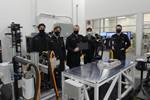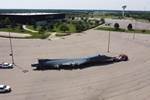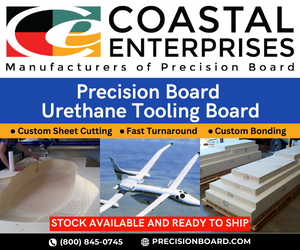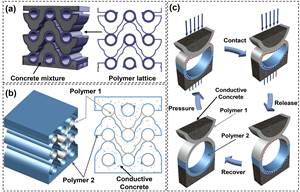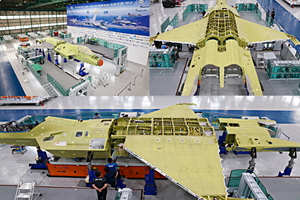Airline safety center departs Sandia Labs for WSU-NIAR
The 30-year Federal Aviation Administration Airworthiness Assurance Center (AANC) program is to combine its knowledge of structural repair, advanced materials and other technologies with a long-standing FAA center at WSU.
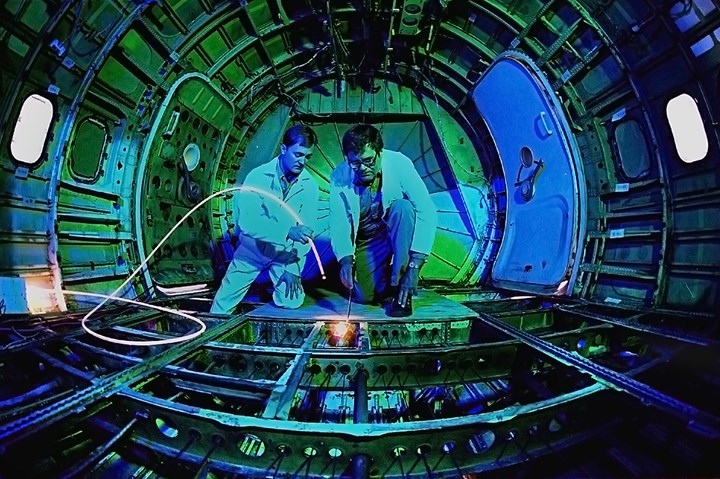
Sandia National Laboratories’ Dennis Roach (left) and Ken Harmon (retired) examine the inside of a Boeing 737 for long-term structural fatigue. Nondestructive techniques allow inspectors to assess the integrity of aircraft structures without disassembly. Photo Credit: Randy Montoya
A 30-year program that is said made flying safer through continued innovations in airplane inspection, maintenance and airworthiness research has ended its tenure at Sandia National Laboratories (Albuquerque, New Mexico).
The Federal Aviation Administration Airworthiness Assurance Center (AANC), operated by Sandia for the FAA, is reported to be moving to the National Institute of Aviation Research at Wichita State University (WSU-NIAR) to combine with another long-standing FAA center. The planned move supports shifts in structure at both Sandia and the FAA.
At the center, Sandia researchers partnered with staff from aircraft manufacturers, airlines, regulatory agencies, universities and industry to develop inspection and maintenance systems for airplanes. The original focus was on developing nondestructive inspection (NDI) techniques for aging airplanes and then grew to include airworthiness assurance needs throughout the lifetime of all aircraft systems.
“Our goal was to develop the technology, prove the technology and, just as importantly, transfer the technology to industry so it could be used routinely to ensure flight safety,” says Senior Scientist Dennis Roach, Sandia’s lead engineer at the center. “The AANC at Sandia became a trusted source of unbiased technology development and validation for an array of programs.”
Roach estimates that more than 100 Sandia researchers contributed to projects at the center. The program brought in $120 million in funding over 30 years.
The center supported a wide range of airplane safety and reliability and new technology application concerns, including operations, structural repair, advanced materials, corrosion monitoring and control, human factors, engine and fuel systems, landing gear, mechanical and electrical systems, structural modeling and analysis, sensor and instrument development, crashworthiness, aircraft certification, information processing and analysis, accident investigation, regulatory and advisory oversight requirements, failure analysis and systems safety.
The center also collaborated with other industries and all branches of the military on multiple engineering system and reliability needs.
Roach says the center staff adapted to and created many changes in the aviation industry. For example, the sole focus on metallic structures shifted into research in composite structures as the next generation of aircraft used these materials as their primary structure. Similarly, hand-deployed NDI methods gave way to automated structural health monitoring (SHM) as the center led the way to the introduction of on-board sensors and use of smart structures to improve damage detection on aircraft.
Some projects of note, including spin-off programs for other industries, include:
- Accident investigations: The center supported accident investigations for TWA800, Swiss Air111, American Airline587 and several rotorcraft accidents. All programs resulted in the introduction of enhanced inspections methods for critical components.
- Space shuttle program: After the space shuttle Columbia accident, the center worked on NASA’s Return to Flight program to develop an inspection system to certify each space shuttle before launch.
- Syncrude/Exxon oil exploration: Composite expertise gained from aviation programs was used to produce new repair methods for high-cycle oil recovery equipment.
- Monitoring bridge health: Expertise from the center’s airplane safety research was applied to monitor the health of bridges.
- Robotic inspection of wind blades: The center’s expertise in NDI was applied to develop a robotic inspection system to monitor the integrity of the blades on wind turbines.
- Aircraft designs for tomorrow: In its work to deploy advanced aircraft maintenance technology and new materials, the center teamed with more than 300 companies and government organizations and conducted Strategic Partnership Projects in 10 countries.
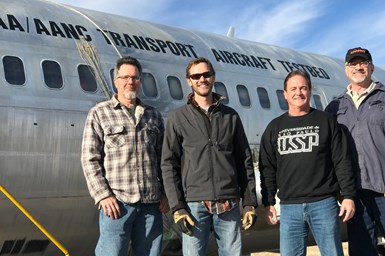
Sandia National Laboratories’ members of the Airworthiness Assurance Center team, from left to right: Clay Newton, Stephen Neidigk, Dennis Roach and Tom Rice, with the 737 aircraft test bed. The 737-200 aircraft, more than 50 years old, served as a full-scale test bed after its career as a passenger plane. The test bed helped develop numerous inspection programs at the center hangar facility Sandia operated at the Albuquerque International Sunport. Photo by Randy Montoya
“I never could have imagined back in 1990 that this program would end up spanning 30 years and contribute so much to commercial aviation safety,” says Dave Galella, FAA program manager. “It was comforting to know that whenever a new airworthiness challenge arose, I could pick up the phone and have access to the vast expertise that resided at the Sandia-AANC.”
During its time at Sandia, the center has received dozens of patents, won nine “Better Way” awards from the Airlines for America and FAA, produced more than 500 publications and formal procedures and helped develop regulatory measures to advance the aviation, aerospace, oil and gas, renewable energy, automotive and nuclear energy industries. The team also worked on multiple international committees to produce worldwide standards for aircraft maintenance.
“The AANC has been a highly successful collaboration offering the opportunity to develop new technologies for aviation assurance that further enabled SHM for our core NNSA physical security program and other programs,” says Sandia Director Gary Laughlin. “Dennis Roach has been a central figure and leader both technically and programmatically in the program from its inception.”
All of the assets acquired during the program, including NDI equipment, test specimens, custom tools, new inventions and an aviation document library were loaded into trucks in late April 2021 and transferred to a new hangar at Wichita State University. Most Sandia researchers working at the center have retired or transferred to other projects at Sandia, while Roach says the transition lines up with his planned retirement and movement into aviation consulting.
Roach estimates that more than 100 Sandia researchers contributed to projects at the center. The program brought in $120 million in funding over 30 years and led to an additional $30 million from industry partnerships.
Related Content
Acellent SHM 4.0 software supports real-time composites monitoring
Integrity and condition of a variety of metal and composite parts and structures is made possible through end-to-end software suites.
Read More21st century concrete: composite metamaterial with super compressability, energy harvesting
Material comprising 3D-printed, auxetic, reinforced polymer lattices in conductive cement matrix can compress up to 15% and generate electricity for lightweight, mechanically tunable structures with energy harvesting and sensing.
Read MoreAcellent contracted to supply SHM systems for KAI KF-21 aircraft
Adaptable custom structural health monitoring (SHM) technology will be used to monitor damage and load of composite aerostructures.
Read MoreEOLIAN kicks off bio-based wind blade development
EU project will develop bio-based, repairable and recyclable vitrimer composites and advanced sensors for highly reliable, sustainable wind blades.
Read MoreRead Next
WSU-NIAR adds automated TP welding and tape-slitting capabilities to ATLAS facility
Systems to aid in welding process developments for the joining of composite structures via fusion bonding, and support AFP demands.
Read MoreAir Force, WSU-NIAR to study operational impacts on legacy B-1B bomber fuselage
NIAR team will perform a complete teardown and comprehensive inspection program of the B-1B 86-0101 structure to enable the B-1 Division to more comprehensively manage the fleet of aging bombers.
Read MoreAll-recycled, needle-punched nonwoven CFRP slashes carbon footprint of Formula 2 seat
Dallara and Tenowo collaborate to produce a race-ready Formula 2 seat using recycled carbon fiber, reducing CO2 emissions by 97.5% compared to virgin materials.
Read More

